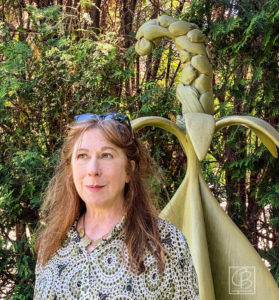Leslie Fry

Over 47 years, my art has ranged from intimate drawings to public sculptures to street performances. Starting with such basic human needs as food, shelter, clothing, and touch, I connect the natural and the constructed worlds. Inspirations span the body/spirit unity in Gothic cathedrals, puppetry, Elizabethan poetry, and Jungian approaches to the wholeness of self.
My public sculptures respond to site, history and the body. Figures are female or hermaphrodite, of imaginary descent, often melded with animal, architecture and plant forms. I create sculptures about transformation that draw on Jung’s “collective unconscious.” Placing the sculptures in public spaces lifts them into our collective consciousness.
Hands, a long-time focus of my art, stand in for the self in recent bronze and ceramic sculpture. Meanings change as the hands gesture release, acceptance and other associated states of being. My own hands model sculptures out of clay, wax, or plaster. Unless clay is fired, I make molds and cast with materials as various as concrete, resin, paper pulp, bronze, and rubber. I also draw, paint, and collage on paper and fabric.
Often working between sculpture, photography and collage, I place cut-out paper images in different environments to photograph the resulting ephemeral interventions. This low-tech, performative process creates unexpected nature/culture juxtapositions. These theatrical images are printed on aluminum or stay in situ for later discovery.
Over 33 years I’ve nurtured the semi-public sculpture garden adjacent to my studio in Winooski, Vermont. Sculpture provides full-sensory experiences, especially when accessible in outdoor spaces rather than inside museums or galleries. Visible from the street, the garden has become well-known, and I give personal tours to those who are interested. Winooski is Vermont’s most diverse and densely populated community, with more than 36 languages spoken in this one-square mile city. I continue to integrate sculpture and landscape toward my ideal sculpture environment – one that is accessible to people from all walks of life and sensitively scaled for human interaction.
I envision sculptures strong enough to hold people, and to be experienced with all five senses in a garden full of colors, scents, birds, and planted edibles for both animals and humans. Gardens bring hope and metaphor to daily life. As statues of influential men topple, perhaps no better time exists to examine values, meaning and feminist history in public statuary.
My sculptures and works on paper have been exhibited internationally in museums and galleries such as Kunsthaus in Hamburg, Zwitscher Machine Gallery in Berlin, Hangaram Art Museum in Seoul, Windspiel Galerie in Vienna, Couvent des Cordeliers in Paris, deCordova Sculpture Park near Boston, Centre des Arts Visuels in Montreal, and Garvey Simon, Ki Smith Gallery, Artists Space, and Wave Hill in New York.
Public sculptures have been commissioned in New York, South Korea, Montreal, Florida, Wisconsin, and Vermont. Public collections include Tufts University, Songchu International Sculpture Park, Freehand New York, Kohler Arts Center, Tampa Museum of Art, Fleming Museum of Art, Musée d’art de Joliette, and St. Petersburg, Florida’s Museum of Fine Arts.
Born in Montreal, I grew up in Vermont, and live in Winooski. My M.F.A. is from Bard College, my B.A. is from the University of Vermont, with a Foundation year at the Central School of Art in London.
“Given the current political climate, in which basic human rights are under attack and human dignity is assailed on a daily basis, Leslie’s formal inventiveness and potent imagery move us to question our relationship to each other, our relationship to the natural world and our beliefs regarding gender roles and identity. Her work serves as a bulwark against the current political tide of fear and oppression we currently find ourselves in and offer a glimmer of hope for what could lie ahead.”
Jeff Feld, Director of 325 Project Space
Exhibition essay for the solo exhibition Polymorphic Polka
“The blending of human, natural, and architectural motifs is a hallmark of Surrealism. Fry steps into this arena with a sword of feminist thinking and cuts through the dogma. Her work shows how Surrealism can reorient our thinking about nature.”
“Stone sprites, nymphs and sphinxes populate the otherworldly garden that sculptor Leslie Fry created, drawing on fairy tales, mythology and ruins for her pieces.”
“These dream-like, even fanciful, forms are quirky, individual, and surprisingly moving. Whether human beings clear a path through nature or merge with it, the artifacts of Fry’s buildings seem to be part of an irrepressible natural order. Demolition becomes construction.”
Anne Barclay Morgan
Sculpture Magazine
“These fantastical sylvan hybrids – the seed of an oak, the seat of the mind – point to the inextricable ties between human consciousness and the natural world.”
Julie K. Hanus
“More than Human”
American Craft Magazine
“Leslie Fry creates delicate, highly charged objects that explore the boundaries between interior and exterior, male and female, clothing and skin. Like a poet who recombines familiar words to describe experience in completely new ways, Fry uses familiar clothing forms, fabrics, and references to the body to create previously unimagined hybrids . . . Her works are at once challenging and funny, vulnerable and defiant.”
Janie Cohen, Director
From the exhibition catalog for Disembodied
Fleming Museum of Art, University of Vermont, Burlington, VT
“It’s springtime, and Leslie Fry’s garden is abloom – with human-like sculptures that, artistically speaking, have one foot in the botanical world and another in ancient architecture. Or medieval culture, or the animal kingdom. It’s an eclectic mix, part fantasy and part metaphor. Fry’s works create a sort of mythical surrealism, where human-looking skin, bone and sinew meld with leaves, roots, tree limbs and animal features. The combined effect bridges the gap between the human and natural worlds, between physical and psychological landscapes.”
Ken Picard
“Body Works”
Seven Days, Burlington, Vermont